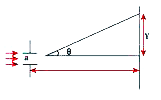Light of wavelength 500 nm passes through a slit of 0.2 mm wide. The diffraction pattern is formed on a screen 60 cm away. Determine the,
angular spread of central maximum
λ=500 nm=500×10−9m,a=0.2 mm=0.2×10−3m,D=60 cm=60×10−2m
Equation for diffraction minimum is, asinθ=nλ
The central maximum is spread up to the first minimum. Hence, n = 1

Rewriting, sinθ=λa (or) θ=sin−1(λa)
Substituting, θ=sin−1(500×10−90.2×10−3)=sin−1(2.5×10−3)
θ=0.0025 rad
Topper's Solved these Questions
- OPTICSBook:NCERT TAMILChapter:OPTICSExercise:EVALUATION (Multiple choice questions)
Explore 20 Videos
- OPTICSBook:NCERT TAMILChapter:OPTICSExercise:EVALUATION (Numerical Problems)
Explore 10 Videos
- NUCLEIBook:NCERT TAMILChapter:NUCLEIExercise:ADDITIONAL EXERCISES
Explore 9 Videos
- RAY OPTICS AND OPTICAL INSTRUMENTSBook:NCERT TAMILChapter:RAY OPTICS AND OPTICAL INSTRUMENTSExercise:EXERCISES
Explore 40 Videos
Similar Questions
A parallel beam of gren light of wavelength 546 nm passes through a slit of width 0.40mm. The transmitted light is collected on a screen 40 cm away. Find the distance between the two first order minima.
View SolutionA parallel beam of green light of wavelength 546 nm passes through a slit of width 0.40mm. The transmitted light is collected on a screen 40 cm away. Find the distance between the two first order minima.
View Solution
Knowledge Check
A beam of light of wavelength 600 nm from a distant source
falls on a single slit 1.0 mm wide and the resulting diffraction pattern is
observed on a screen 2m away. What is the distance between the first dark
fringe on either side of the central bright fringe?A1.2cmB1.2mmC2.4cmD2.4mm
Light of wavelength 500 nm falls normally on a slit of width 1μm producing Fraunhofer diffraction pattern on a screen. Calculate the angular position of the first minimum and the angular width of the central maximum.
View SolutionA parallel beam of light of wavelength 500 nm falls on a narrow slit and the resulting diffraction pattern is obtained on a screen 1 m away. If the first minimum is formed at a distance of 2.5 mm from the centre of the screen, find the
(i) width of the slit, and
(ii) distance of first secondary maximum from the centre of the screen.
View SolutionA beam of light of wavelength 600 nm from a distant source
falls on a single slit 1.0 mm wide and the resulting diffraction pattern is
observed on a screen 2m away. What is the distance between the first dark
fringe on either side of the central bright fringe?
View SolutionA beam of light of wavelength 600 nm from a distant source
falls on a single slit 1.0 mm wide and the resulting diffraction pattern is
observed on a screen 2m away. What is the distance between the first dark
fringe on either side of the central bright fringe?
View SolutionA beam of light of wavelength 600 nm from a distant source falls on a single slit 1.0 mm wide and the resulting diffraction pattern is observed on a screen 2 m away What is the distance between the second bright fringe on either side of the central bright fringe ?
View SolutionA beam of light of wavelength 600 nm from a distant source falls on a single slit 1.0 mm wide and the resulting diffraction pattern is observed on a screen 2 m away What is the distance between the second bright fringe on either side of the central bright fringe ?
View SolutionA monochromatic light of wavelength 500nm is incident normally on a single slit of width 0.2mm to produce a diffraction pattern. Find the angular width of central maximum obtained on the screen, 1m away.
Estimate the number of fringes obtained in YDSE with fringe width 0.5mm, which can be accommodated within the region of total angular spread of the central maximum due to a single slit.
View Solution
